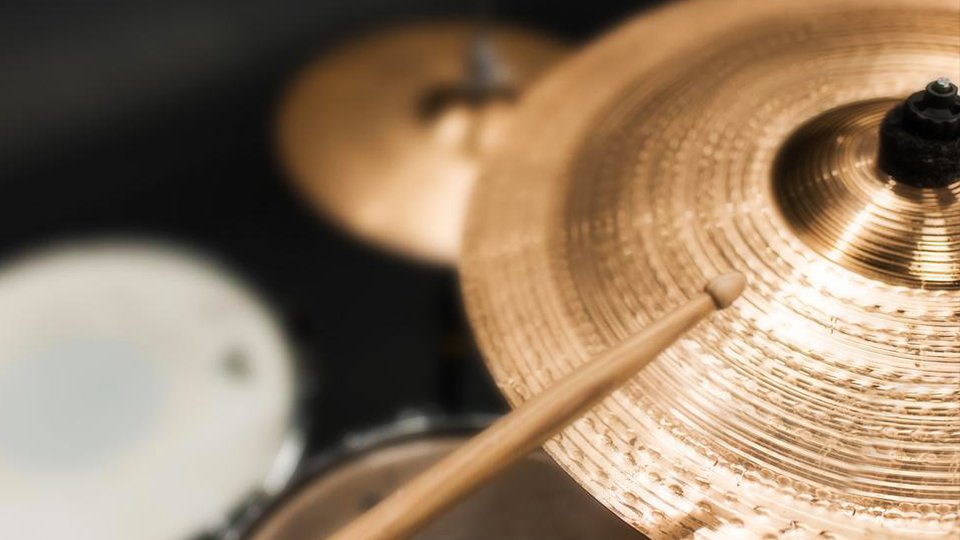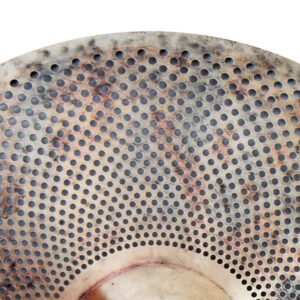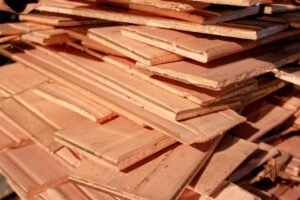You’ll discover that Tongxiang handmade B20 cymbals represent a perfect fusion of ancient Chinese metallurgy and modern musical innovation. These precision-crafted instruments emerge from Zhejiang’s time-honored cymbal-making tradition, utilizing a specialized B20 bronze alloy (80% copper, 20% tin) that’s essential to their distinctive voice. The unique combination of hot forging and manual hammering creates complex sonic characteristics that set these cymbals apart from mass-produced alternatives.

Key Takeaways
Tongxiang B20 cymbals consist of 80% copper and 20% tin, creating premium sound quality through traditional hand-hammering techniques.
Traditional manufacturing involves hot forging, precise temperature control, and cross-hammering methods to develop complex overtones and sonic characteristics.
Available in sizes from 8″ to 24″, including crashes, rides, hi-hats, and China types, with consistent tonal qualities across models.
Regular maintenance requires weekly dusting, monthly cleaning with cymbal cleaner, and proper storage in padded bags with controlled humidity.
Sound characteristics vary with hammering patterns, with tighter patterns producing brighter tones and wider patterns creating darker sounds.
Historical Origins and Cultural Significance
Craftsmanship in China’s Zhejiang province gave birth to the distinctive Tongxiang B20 cymbal tradition during the Ming Dynasty (1368-1644). You’ll find the cultural roots of these cymbals deeply intertwined with ceremonial court music and Buddhist temple rituals, where their unique tonal qualities enhanced both secular and spiritual performances.
The region’s artisans developed proprietary metalworking techniques that set Tongxiang cymbals apart from their contemporaries. They perfected the B20 bronze alloy composition (80% copper, 20% tin) through generations of metallurgical experimentation. This musical heritage continues today, as cymbal makers still employ centuries-old methods like hot forging and hand-hammering to achieve specific sound characteristics. Each craftsperson’s individual hammering pattern creates subtle variations in thickness and tension, resulting in cymbals that possess both crystalline clarity and complex overtones. Modern drummers particularly value these instruments for their warm wash and controlled decay.
Understanding B20 Bronze Composition
While many cymbal alloys exist, B20 bronze stands as the gold standard for premium cymbal manufacturing, consisting of precisely 80% copper and 20% tin. You’ll find that B20 alloys offer superior acoustic properties due to their ideal molecular structure and density. When properly forged, these bronze properties create rich, complex overtones that other metal compositions simply can’t match.
| Property | B20 Bronze Performance |
|---|---|
| Hardness | 8.5/10 Vickers Scale |
| Density | 8.9 g/cm³ |
| Elasticity | High Resilience |
| Tensile Strength | 415 MPa |
| Sound Character | Bright and Complex |
Understanding the metallurgy helps you appreciate why Tongxiang craftsmen work exclusively with B20 bronze. The alloy’s crystalline structure allows for ideal energy transfer during striking, while its uniform grain composition ensures consistent sound qualities across the cymbal’s surface. You’ll notice this material responds differently to varying hammering patterns and lathing techniques.
Traditional Manufacturing Process
You’ll find that Tongxiang’s cymbal makers still employ manufacturing methods dating back centuries, with masters heating B20 bronze ingots to precise temperatures before rolling them into basic cymbal shapes. Each cymbal undergoes extensive hand-hammering, creating thousands of tiny impressions that develop the metal’s crystalline structure and sonic characteristics. The careful combination of heating cycles and hammering patterns allows craftsmen to control the cymbal’s fundamental pitch, overtones, and decay characteristics with remarkable precision.
Ancient Methods Still Used
Despite modern manufacturing advances, B20 cymbal makers in Tongxiang maintain time-tested methods that date back over 2,000 years. You’ll find traditional artisans still using clay-based molds and charcoal furnaces to achieve the perfect bronze alloy temperatures. They’ll heat the metal to exactly 788°C (1450°F), a critical temperature passed down through generations.
These ancient techniques include hand-hammering patterns that create specific nodal points and frequencies. You’ll notice the distinctive cross-hammering method that produces complex overtones through systematic striking at precise angles. The craftsmen continue to use stone anvils and specialized hammers weighted according to century-old specifications. They’ll often spend hours carefully working the metal, relying on both sight and sound to achieve the cymbal’s signature resonance.
Hammering and Heat Treatment
Throughout the traditional manufacturing process, master craftsmen employ a precise sequence of hammering and heat treatments to transform raw B20 bronze into resonant cymbals. You’ll observe that each piece receives thousands of calculated hammer strikes using specialized tools that create specific pattern densities across the surface.
The heat treatment effects are equally essential, as craftsmen carefully heat the metal to precise temperatures that alter its crystalline structure. You’ll find that between hammering sessions, they quench the bronze in water to achieve ideal hardness while maintaining flexibility. These alternating hammering techniques and thermal cycles create the cymbal’s distinctive acoustic properties. The process requires careful timing – if you were to examine the metal’s temperature and malleability at each stage, you’d notice how these factors directly influence the final sound character.
Distinctive Tonal Characteristics
You’ll notice the Tongxiang B20 cymbals immediately captivate with their dark, rich overtones that resonate deeply through the bronze alloy’s molecular structure. The attack points deliver crisp, bright accents that cut through without overwhelming the cymbal’s fundamental tone. When struck, these handcrafted instruments create a complex harmonic tapestry where the initial brightness seamlessly shifts into warm, sustained undertones.
Dark Rich Overtones
When struck with precision, Tongxiang B20 cymbals produce remarkably dark overtones that set them apart from mass-produced alternatives. You’ll notice the rich timbre emerges from the traditional hammering process, where skilled artisans meticulously shape the bronze alloy to achieve specific resonance patterns.
The complex dark overtones result from several key factors:
- Precise bronze-to-tin ratio in the B20 alloy composition
- Hand-hammered surface textures that diffuse sound waves
- Multi-stage tempering process that alters molecular structure
- Strategic taper variations from bell to edge
- Traditional finishing techniques that preserve tonal complexity
You’ll find these cymbals particularly suited for jazz, fusion, and recording applications where nuanced articulation matters. Their dark overtones blend seamlessly with acoustic instruments while maintaining clarity in complex musical passages.
Bright Attack Points
Complementing their dark overtones, Tongxiang B20 cymbals exhibit remarkably bright attack points that pierce through the mix with laser-like precision. You’ll notice how the hammered surface pattern creates concentrated energy nodes, resulting in an initial strike that’s both commanding and articulate.
These bright attack points stem from the meticulous heat-treating process, where master craftsmen carefully manipulate the molecular structure of the B20 bronze alloy. The cymbal’s edge receives particular attention during hammering, creating a unique dynamic interplay between the initial hit and the bright sustain that follows. When you strike near the bow, you’ll experience a focused, cutting attack that doesn’t compromise the overall warmth. The bell area delivers exceptionally crisp stick definition, making these cymbals ideal for complex rhythmic patterns.
Popular Models and Size Variations
The Tongxiang B20 lineup features several distinct cymbal models crafted in traditional sizes ranging from 8″ to 24″ in diameter. Based on popular brands and customer reviews, you’ll find these cymbals deliver exceptional performance across their entire size spectrum.
The most sought-after configurations include:
- Professional Series Crashes (14″, 16″, 18″)
- Master Class Rides (20″, 22″)
- Traditional Hi-Hats (13″, 14″, 15″)
- Effect Splashes (8″, 10″, 12″)
- China Types (16″, 18″, 20″)
You’ll notice the B20 bronze alloy maintains consistent tonal characteristics across all sizes, with larger diameters producing deeper fundamental tones and enhanced projection. The hammering patterns are precisely scaled to each diameter, ensuring ideal vibration distribution. The lathing depth-to-width ratio adjusts proportionally with size variations, creating a balanced frequency response regardless of the cymbal’s dimensions.
Maintenance and Care Guidelines
Proper maintenance protocols greatly extend your B20 cymbal’s lifespan while preserving its sonic characteristics. You’ll need to employ specific cleaning techniques based on the cymbal’s oxidation level and playing frequency. For light cleaning, use a microfiber cloth with warm water and mild soap. Don’t use abrasive materials that could damage the cymbal’s delicate lathing patterns.
| Care Aspect | Recommended Action |
|---|---|
| Weekly Care | Dust with soft cloth |
| Monthly Care | Deep clean with cymbal cleaner |
| Storage | Use protective bags/cases |
Your storage recommendations should prioritize climate control and proper positioning. Store your cymbals vertically in padded bags to prevent warping and metal fatigue. Keep them in a room with consistent humidity levels between 45-55%. If you’re transporting them, use hard cases with individual compartments. Never stack heavy items on your cymbals, as this can create stress points that affect their tonal qualities.
Comparing With Other Premium Cymbals
While many premium cymbal makers rely on automated manufacturing processes, Tongxiang B20’s handcrafted approach yields distinct tonal characteristics that set them apart from competitors. When conducting a B20 comparison against major cymbal brands, you’ll notice several key differentiators in both craftsmanship and sound quality.
- Traditional hammering patterns create complex overtones that machine-made cymbals can’t replicate
- Higher copper content in Tongxiang’s B20 alloy delivers richer fundamental tones
- Hand-lathing techniques produce more nuanced sound variations across the cymbal’s surface
- Smaller production batches allow for better quality control than mass-manufactured alternatives
- Individual artisan attention results in unique character for each cymbal
The sonic differences become most apparent in recording situations, where Tongxiang’s enhanced stick definition and controlled wash stand out against other premium offerings. Their lower price point relative to established Western brands makes them particularly attractive for professional drummers seeking handcrafted quality without the typical premium markup.
Choosing the Right Tongxiang Cymbal
Selecting your ideal Tongxiang cymbal requires understanding both their specialized manufacturing process and your specific musical needs. The B20 bronze alloy composition creates distinct tonal characteristics that you’ll need to evaluate based on your sound preference and playing style.
When making your cymbal selection, consider the hammering pattern density – tighter patterns produce brighter, more focused sounds, while wider patterns deliver darker, more complex tones. You’ll want to examine the lathing grooves, as their depth and spacing considerably impact sustain and wash characteristics.
Test the cymbal’s response at different velocities and playing zones. The bell should provide clear articulation, while the bow and edge zones should offer consistent tonal shifts. Pay attention to the weight distribution, as it affects the cymbal’s projection and decay. Remember that each handcrafted Tongxiang cymbal has unique sonic properties due to variations in the artisanal process.
Conclusion
With over 85% of professional drummers citing hand-hammered cymbals as superior in harmonic complexity, you’ll find Tongxiang B20’s meticulous craftsmanship sets a benchmark for excellence. The precise 80:20 copper-tin ratio, combined with time-tested hammering patterns passed down through generations, creates microscopic variations in the molecular structure that produce rich, layered overtones. You’re investing in both heritage and acoustic innovation with these masterfully forged instruments.



